PRELIMINARY RESULTS
by
J. FUCHS
IFREMER
Department of Living Ressources/Aquaculture Ressources
Before presenting the results of the survey on research capacity and needs in each countries, some general figures on aquaculture production in Mediterranean countries are presented thereafter.
Total volum of production both in fresh and seawater (brackish and seawater) is analysed in each country and geographical area (zone I Yugoslavia, zone II Syria, zone III Lybia, zone IV Morocco).
These basic informations on total production in tons will give ideas on relative importance of aquaculture activity in the differents countries.
Data collected from 1987 to 1990 are summarized in table.1 and illustrated by figure 1: total aquaculture production; figure 2: production in sea and brackishwater and figure 3: production in freshwater.
I. 1 - Total production (table 1):
150 000 tons in 14 countries among with 59% (87 644 T) are freshwater species again 41% (61 478 T) in brackish and seawater.
I.2 - Major areas of production (table 1):
Classification of production by zone givess:
86 637 or 60% in zone III (Lybia)
48 131 or 32% in zone I (Yugoslavia)
10 8314 or 7% in zone IV (Morocco)
1 473 or 1% in zone II (Syria)
I.3 - Major counties of production (figure 1)
Four most important countries are producing 92% of total aquaculture:
TABLE 1 - MEDRAP II : CAPACITY AND WEEDS IN RESEARCH - AQUACULTURE PRODUCTION
| AREA | COUNTRY | SW + BW | FW | TOTAL | Major Species |
| I | YUGOSLAVIA | 2500 | 25000 | 27500 | oyster, bass, bream, eel, carp, trout |
| BULGARIA | 850 | 12000 | 12850 | mussel, mugil, pleuronectes, palaemon | |
| ALBANIA | 3500 | 625 | 4125 | mussel, carp, trout | |
| TURKEY | 300 | 3356 | 3656 | crayfish, catfish, carp, trout | |
| TOTAL | 7150 | 40981 | 48131 | ||
| II | CYPRUS | 50 | 73 | 123 | trout, bass, bream |
| LEBANON | 100 | 100 | trout | ||
| SYRIA | 1300 | 1300 | carp, tilapia, trout | ||
| TOTAL | 50 | 1473 | 1523 | ||
| III | EGYPT | 44800 | 43800 | 88600 | mugil, tilapia, carp,clarius, perch |
| LIBYA | 2 | 30 | 32 | bass, bream, shrimps | |
| MALTA | 5 | 5 | tilapia, bass, bream, clams | ||
| TOTAL | 44807 | 43830 | 88637 | ||
| IV | MOROCCO | 540 | 540 | oyster, clams, bass, bream, eel, peneide | |
| ALGERIA | 45 | 379 | 424 | oyster, mussel, carp, mullet | |
| TUNISIA | 1416 | 3 | 1419 | clams, oyster, mussel, bass, bream, sole, pe | |
| PORTUGAL | 7470 | 978 | 8448 | oyster, mussel, bass, bream, eel, trout | |
| TOTAL | 9471 | 1360 | 10831 | ||
| TOTAL (1+2+3+4) | 61478 | 87644 | 149122 |
FIGURE 1 - TOTAL PRODUCTION OF AQUACULTURE IN MEDRAP COUNTRIES
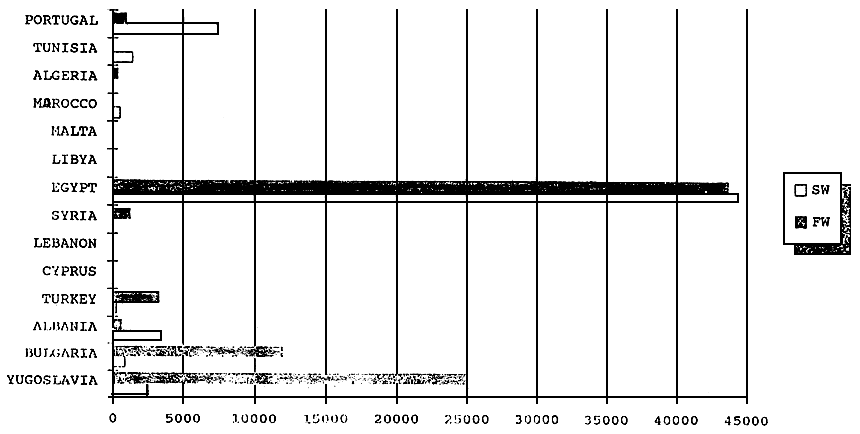
FIGURE 2 - SEA AND BRACKISHWATER AQUACULTURE PRODUCTION IN MEDRAP II COUNTRIES
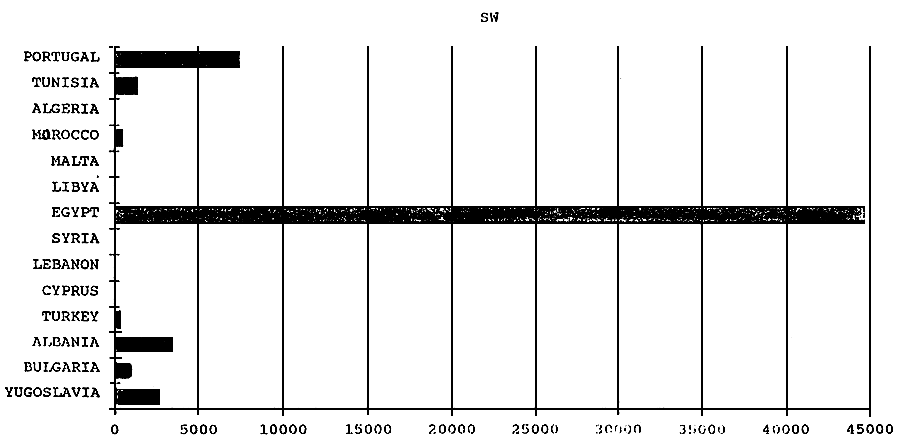
FIGURE 3 - FRESHWATER AQUACULTURE PRODUCTION IN MEDRAP II COUNTRIES

Table 2 - SPECIES OF MAJOR INTEREST FOR AQUACULTURE IN FW AND SW
| FW | ZONE I | ZONE II | ZONE II | ZONE IV | TOTAL | SW+BW | ZONE I | ZONE II | ZONE II | ZONE IV | TOTAL |
| Y-B-A-T | C-L-S | E-L-M | M-A-T-P | Y-B-A-T | C-L-S | E-L-M | M-A-T-P | ||||
| TROUT | 3 | 3 | 1 | 7 | MUSSEL | 2 | 3 | 5 | |||
| CARP | 3 | 1 | 1 | 1 | 6 | OYSTER | 1 | 4 | 5 | ||
| TILAPIA | 1 | 2 | 3 | CLAMS | 1 | 2 | 3 | ||||
| EEL | 1 | 2 | 3 | ||||||||
| CLARIA | 1 | 1 | SEABASS | 1 | 1 | 2 | 3 | 7 | |||
| CATFISH | 1 | 1 | SEABREAM | 1 | 1 | 2 | 3 | 7 | |||
| CRAYFISH | 1 | 1 | MULLET | 1 | 1 | 1 | 3 | ||||
| FLATFISH | 1 | 1 | 2 | ||||||||
| SHRIMPS | 1 | 1 | 2 |
I.4 - Detailed production in brakishwater and seawater (figure 2)
Egypt is the major producer with more that 40 000 T/Year (72%), followed by Portugal with 7 470 T (12%), Albania ; 3 500 T (6%) and Yugoslavia : 2 500 T k(4%). Production is inferior to 1 000 T in Bulgaria, Morocco and Tunisia, and very limited in the others 7 countries.
I.5 - Detailed production in freshwater (figure 2)
Egypt is also the first producer of freshwater species with 43 800 T (50% of the total). Bulgaria and Yugoslavia also produce a large quantity of freshwater fish with respective 12 000 (14%) and 25 000 T/Year (29%).
Turkey. Albania, Syria and Portugal are producing between 500 to 3 000 T/Year and the others 7 countries around 100 T/year.
I.6 -Species of major interest
Table 2 gives an idea of the most important species for aquaculture in brackish, seawater and freshwater, and their repartition in each area.
• Freshwater species :
Trouts and carps are the 2 most important species, respectively present in 7 and 6 countries again 3 for tilapia. The distribution in each country is indicated in table 2.
• Seawater species :
Molluses: mussels and oysters are mainly grown in zone 1 and 4 and relatively important in Morocco and Tunisia.
FinFish seabass and seabream are reared in 7 countries, mullet in 3 and sole and flotfish in 2 countries.
I.7 - Conclusion
- With a total production of 150 000 Tons, the 14th countries involved involved in MEDRAP II represent important important potential for the futur.
- This production in mainly concentrated in 4 countries (Egypt, Yugoslavia Bulgaria and Portugal) with 92% of the total production. Egypt itself produce 60% of aquaculture (30% in freshwater and 30% in seawater).
- Diversity is one of the characteristic of this aquaculture with specific production for each area and countries.
- Freshwater aquaculture in concentrated on a very limited number of species (trouts, carps and tilapia), and in the country a large number of species (molluscs, fish, shrimps) is concerned by aquaculture in brakish and seawater.
II.1 - Remarks
Several difficulties have been encountered in the realization of this analysis:
• Lack of information:
Some countries sent very limited informations on their capacity and needs for research
| ZONE | COUNTRY | INFORMATIONS GAINED |
| I | YUGOSLAVIA | A |
| BULGARIA | A | |
| ALBANIA | A | |
| TURKEY | A | |
| II | CYPRUS | A |
| LEBANON | B | |
| SYRIA | C | |
| III | EGYPT | C |
| LIBYA | C | |
| MALTA | A | |
| IV | MOROCCO | B |
| ALGERIA | B | |
| TUNISIA | A | |
| PORTUGAL | C |
• Detailed research programs
Very few informations have been gained on detailed description of major on going and planned research programs.
II.2 - Identification of research topics
After analysis of the results of the survey on “research capacity and needs” within countries involved in MEDRAP II, 6 areas of research of major interest have been identified and classified:
Development and improvement of rearing technics for all species including management, production of Artemia, weaning…
Basic research on biology of species : reproduction and breeding, pathology, nutrition and genetic (selection of strain, hybridization).
Diversification of species both in fresh and seawater
Environnemental aspect : Site selection, sanitary quality of products, impact of aquaculture on environnement, treatment of effluent.
Studies of lagunal ecosystems
Offshore-cage culture
The classification has been choosen to present the situation of on going and planned research programs in each country and geographical area
II.3 - Principal on-going and planned research programmes conducted in zone 1 (Yugoslavia, Bulgaria, Turkey and Albania) (table 3 and figure 4)
- Aquaculture production in zone 1
| AREA | COUNTRY | SW + BW | FW | TOTAL |
| I | YUGOSLAVIA | 2500 | 25000 | 27500 |
| BULGARIA | 850 | 12000 | 12850 | |
| ALBANIA | 3500 | 625 | 4125 | |
| TURKEY | 300 | 3356 | 3656 | |
| TOTAL | 7150 | 40981 | 48131 |
The preliminary synthesis illustred in table 3 and figure 4 indicate that, except in the case of pathology (Bulgaria and Turkey) ar breeding (Turkey and Yugoslavia), ongoing research programmes strongly vary from country to country.
In the contrary, among the programmes which are planned for the futur, 3 areas of major interest have been identified:
- Diversification in 3 countries,
- Pathology in 3 countries,
- Nutrition in 2 countries,
- Environnement in 2 countries,
Priorities for research in zone 1 are:
| - | Pathology of freshwater and seawater species: | 4 countries |
| - | Diversification: | 3 countries |
| - | Breeding and nutrition: | 2 countries |
| - | Impact aquaculture/environnement: | 2 countries |
| - | Genetic, site selection and ecosystem in lagon: | 1 country |
Table 3 SYNTHESIS OF ON-GOING AND PLANNED PROGRAMME IN ZONE 1
| PROGRAME | ALBANIA | BULGARIA | TURKEY | YUGOSLAVIA | TOTAL | |
| ON-GOING PROGRAMMES | BREEDING | X(Catfish) | X (SW) | 2 | ||
| PATHOLOGY | X (SW) | X (Crayfish) | 2 | |||
| NUTRITION | ||||||
| GENETIC | X (Hybri) | 1 | ||||
| DIVERSIFICATION | X (SW) | 1 | ||||
| SITE SELECTION | ||||||
| IMPACT AQUA/ENVIR | X | 1 | ||||
| TREATMENT EFFLUENTS | ||||||
| OFF-SHORE CAGE CULTURE ECOSYST LAGON | X | 1 | ||||
| PLANNED PROGRAMMES | BREEDING | |||||
| PATHOLOGY | X | X | X | 3 | ||
| NUTRITION | X | X | 2 | |||
| GENETIC | ||||||
| DIVERSIFICATION | X (Mussel) | X (Mussel) | X (FW) | 3 | ||
| SITE SELECTION | X (Mussel) | 1 | ||||
| IMPACT AQUA/ENVIR | X | 1 | ||||
| TREATMENT EFFLUENTS | ||||||
| OFF-SHORE CAGE CULTURE ECOSYST LAGON |
FIGURE 4 SYNTHESIS OF ON-GOING AND PLANNED RESEARCH PROGRAMME IN ZONE I
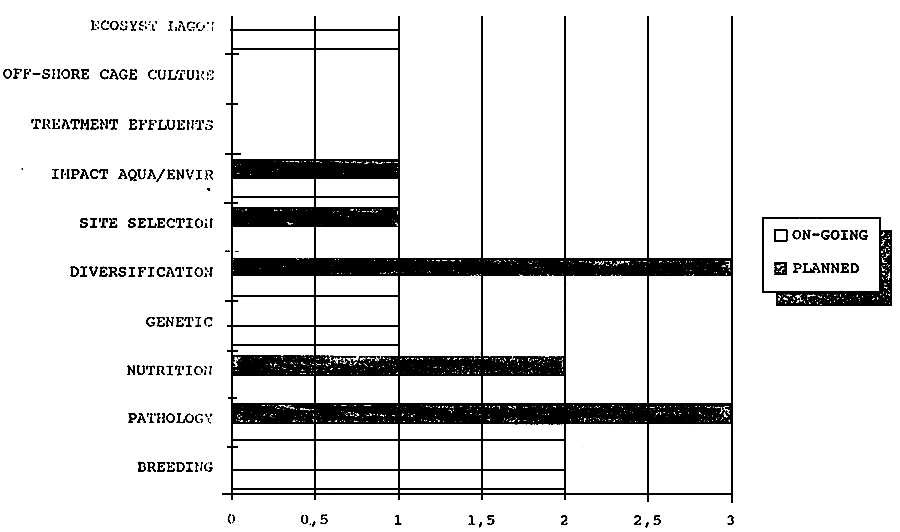
II.4 - On going and planned research programs in zone II (Cyprus, Lebanon and Syria) (table 4 and figure 5)
- Aquaculture Production IN Zone II
| AREA | COUNTRY | SW + BW | FW | TOTAL |
| II | CYPRUS | 50 | 73 | 123 |
| LEBANON | 100 | 100 | ||
| SYRIA | 1300 | 1300 | ||
| TOTAL | 50 | 1473 | 1523 |
Data concern only Cyprus and Lebanon.
Cyprus concentrates his research effort on diversification and studies on impact of aquaculture on environnement. Lebanon research institute works on site selection. Additional priorities for the futur are breeding and treatment of effluents for Cyprus and diversification on mussels for Lebanon.
Diversification is the only research program of commun interest for both countries.
Table 4 - SYNTHESIS OF ON-GOING AND PLANNED RESEARCH PROGRAMMES IN ZONE II
| PROGRAMME | CYPRUS | LEBANON | SYRIA | TOTAL | |
| ON-GOING PROGRAMMES | NO DATA | ||||
| BREEDING | |||||
| PATHOLOGY | |||||
| NUTRITION | |||||
| GENETIC | |||||
| DIVERSIFICATION | X (SW) | 1 | |||
| SITE SELECTION | X | 1 | |||
| IMPACT AQUA/ENVIR | X (SW) | 1 | |||
| TREATMENT EFFLUENTS | |||||
| OFF-SHORE CAGE CULTURE | |||||
| ECOSYST LAGON | |||||
| PLANNED PROGRAMMES | BREEDING | X (SW) | 1 | ||
| PATHOLOGY | |||||
| NUTRITION | |||||
| GENETIC | |||||
| DIVERSIFICATION | X (Mussel) | 1 | |||
| SITE SELECTION | |||||
| IMPACT AQUA/ENVIR | |||||
| TREATMENT EFFLUENTS | X (SW) | 1 | |||
| OFF-SHORE CAGE CULTURE | |||||
| ECOSYST LAGON |
FIGURE 5 - SYNTHESIS OF ON-GOING AND PLANNED RESEARCH PROGRAMMES IN ZONE II

II.5 - On-going and planned research programs in zone III (Egypt, Lybia and Malta) (table 5 and figure 6)
- Aquaculture Production IN Zone III
| AREA | COUNTRY | SW + BW | FW | TOTAL |
| III | EGYPT | 44800 | 43800 | 88600 |
| LIBYA | 2 | 30 | 32 | |
| MALTA | 5 | 5 | ||
| TOTAL | 44807 | 43830 | 88637 |
Few data are available on this area except in the case of Malta who concentrate his research activity on 4 programs of major interest: nutrition, pathology, genetic and diversification. Lybia only indicate research conducted on nutrition.
Among the planned programme, Egypt indicate strong interest for basic research on biology of the species (breeding, pathology, nutrition and genetic).
Basic research and diversification are the major programms of research considered in this zone 3.
Table 5 - SYNTHESIS OF ON-GOING RESEARCH PROGRAMMES IN ZONE III
| PROGRAMME | EGYPT | LIBYA | MALTA | TOTAL | |
| ON-GOING PROGRAMMES | BREEDING | ||||
| PATHOLOGY | X | 1 | |||
| NUTRITION | X | X | 2 | ||
| GENETIC | X (SexRev) | 1 | |||
| DIVERSIFICATION | X (SW) | 1 | |||
| SITE SELECTION | |||||
| IMPACT AQUA/ENVIR | |||||
| TREATMENT EFFLUENTS | |||||
| OFF-SHORE CAGE CULTURE | |||||
| ECOSYST LAGON | |||||
| PLANNED PROGRAMMES | BREEDING | X | X (SW) | 2 | |
| PATHOLOGY | X | 1 | |||
| NUTRITION | X | 1 | |||
| GENETIC | X | 1 | |||
| DIVERSIFICATION | |||||
| SITE SELECTION | |||||
| IMPACT AQUA/ENVIR | |||||
| TREATMENT EFFLUENTS | |||||
| OFF-SHORE CAGE CULTURE | |||||
| ECOSYST LAGON |
II-6 - On going and planned research programs in zone IV (Marocco, Algeria, Tunisia and Portugal) (table 6 and figure 7)
Aquaculture production in Zone 4
| AREA | COUNTRY | SW + BW | FW | TOTAL |
| IV | MAROCCO | 540 | 540 | |
| ALGERIA | 45 | 379 | 424 | |
| TUNISIA | 1416 | 3 | 1419 | |
| PORTUGAL | 7470 | 978 | 8448 | |
| TOTAL | 9471 | 1360 | 10831 |
On-going research programs varied from country to country in zone IV with basic research on biology of species, diversification and environnemental research in Portugal, nutrition and pathology in Tunisia, off-shore cage culture and ecosystem in lagon research in Algeria, Marocco is concentrating in research site selection.
Among the research programmes proposed for the futur, diversification and studies of ecosystem in lagons are been identified as prioritary.
Classification of priorities for this zone give:
| - | Diversification: | 4 countries |
| - | Breeding: | 3 countries |
| - | Nutrition: | 3 countries |
| - | Ecosystem: | 3 countries |
| - | Off shore aquaculture: | 2 countries |
| - | Environmental aspect: | 2 countries. |
FIGURE 6- SYNTHESIS OF ON-GOING AND PLANNED RESEARCH PROGRAMMES IN ZONE III
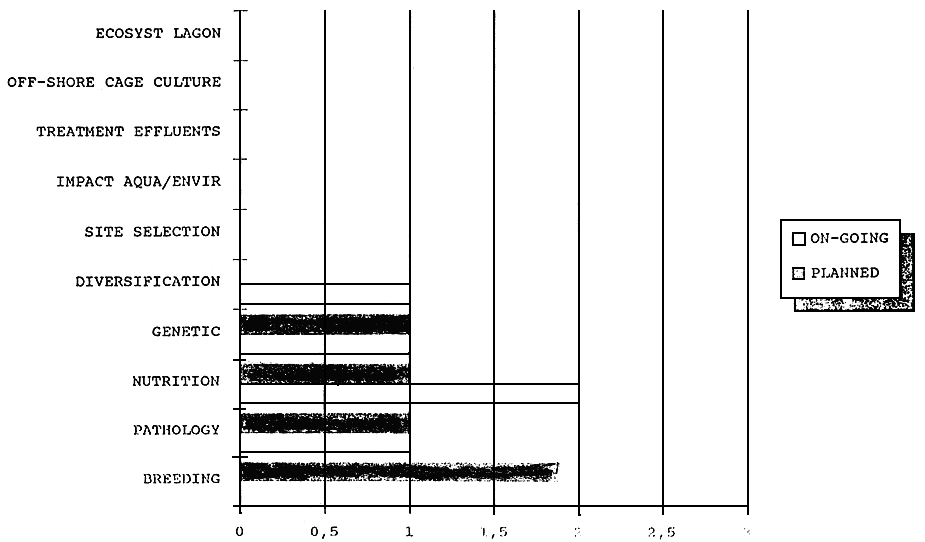
Table 6 - SYNTHESIS OF ON-GOING AND PLANNED RESEARCH PROGRAMME III ZONE IV
| PROGRAMME | MOROCCO | ALGERIA | TUNISIA | PORTUGAL | TOTAL | |
| ON-GOING PROGRAMMES | BREEDING | |||||
| PATHOLOGY | X(SW) | X | 2 | |||
| NUTRITION | X(SW) | X | 2 | |||
| GENETIC | ||||||
| DIVERSIFICATION | X | 1 | ||||
| SITE SELECTION | X | 1 | ||||
| IMPACT AQUA/ENVIR | X | 1 | ||||
| TREATMENT EFFLUENTS | ||||||
| OFF-SHORE CAGE CULTURE | X (Moll) | 1 | ||||
| ECOSYST LAGON | X(FW) | 1 | ||||
| PLANNED PROGRAMMES | BREEDING | X | 1 | |||
| PATHOLOGY | ||||||
| NUTRITION | X | 1 | ||||
| GENETIC | ||||||
| DIVERSIFICATION | X (Moll) | X | X | 3 | ||
| SITE SELECTION | ||||||
| IMPACT AQUA/ENVIR | ||||||
| TREATMENT EFFLUENTS | ||||||
| OFF-SHORE CAGE CULTURE | X | 1 | ||||
| ECOSYST LAGON | X | X (FW) | 2 |
FIGURE 7 SYNTHESIS OF ON-GOING AND PLANNED PROGRAMMES IN ZONE IV

A global synthesis including both on-going and planned research programmes is presented in table 7 and is illustrated by figures 8–9.
Although data have to be verified and completed a preliminary classification of commun major areas of research for the countries involved in MEDRAP II is presented:
Diversification appeared to be the most important item, identified by 80% of the countries.
Basic research on pathology and nutrition are also considered as prioritary by 60% of the countries, again 40% for breeding
Environnemental aspects are also nominated by 60% of the countries as prioritary: impact of aquaculture on environnement (30%) and site selection (20%).
This classification is illustred in figure №9 which give an idea of the relative importance of the different research programmes (on going-planned) in the geographical zones.
Table 7- GLOBAL SYNTHESIS OF ON-GOING AND PLANNED RESEARCH PROGRAMMES
| ZONE 1 | ZONE 2 | |||||||
| ALBANIA | BULGARIA | TURKEY | YUGOSLAVIA | CYPRUS | LEBANON | SYRIA | ||
| BREEDING | 1 | 1 | ||||||
| PATHOLOGY | 1 | 1 | ||||||
| NUTRITION | ||||||||
| GENETIC | 1 | |||||||
| ON-GOING | DIVERSIFICATION | 1 | 1 | |||||
| PROGRAMMES | ||||||||
| SITE SELECTION | 1 | |||||||
| IMPACT AQUA/ENVIR | 1 | 1 | ||||||
| TREATMENT EFFLUENTS | ||||||||
| OFF-SHORE CAGE CULTURE | ||||||||
| ECOSYST LAGON | 1 | |||||||
| BREEDING | 1 | |||||||
| PATHOLOGY | 1 | 1 | 1 | |||||
| NUTRITION | 1 | 1 | ||||||
| GENETIC | ||||||||
| PLANNED | DIVERSIFICATION | 1 | 1 | 1 | 1 | |||
| PROGRAMMES | ||||||||
| SITE SELECTION | 1 | |||||||
| IMPACT AQUA/ENVIR | 1 | |||||||
| TREATMENT EFFLUENTS | 1 | |||||||
| OFF-SHORE CAGE CULTURE | ||||||||
| ECOSYST LAGON | ||||||||
| ZONE 3 | ZONE 4 | ||||||||
| EGYPT | LIBYA | MALTA | MAROCCO | ALGERIA | TUNISIA | PORTUGAL | TOTAL | ||
| BREEDING | 2 | ||||||||
| PATHOLOGY | 1 | 1 | 1 | 5 | |||||
| NUTRITION | 1 | 1 | 1 | 1 | 4 | ||||
| GENETIC | 1 | 2 | |||||||
| ON-GOING | DIVERSIFICATION | 1 | 1 | 4 | |||||
| PROGRAMMES | |||||||||
| SITE SELECTION | 1 | 2 | |||||||
| IMPACT AQUA/ENVIR | 1 | 3 | |||||||
| TREATMENT EFFLUENTS | |||||||||
| OFF-SHORE CAGE CULTURE | 1 | 1 | |||||||
| ECOSYST LAGON | 1 | 2 | |||||||
| BREEDING | 1 | 1 | 1 | 4 | |||||
| PATHOLOGY | 1 | 4 | |||||||
| NUTRITION | 1 | 1 | 4 | ||||||
| GENETIC | 1 | 1 | |||||||
| PLANNED | DIVERSIFICATION | 1 | 1 | 1 | 7 | ||||
| PROGRAMMES | |||||||||
| SITE SELECTION | 1 | ||||||||
| IMPACT AQUA/ENVIR | 1 | ||||||||
| TREATMENT EFFLUENTS | 1 | ||||||||
| OFF-SHORE CAGE CULTURE | 1 | 1 | |||||||
| ECOSYST LAGON | 1 | 1 | |||||||
| 2 | |||||||||
FIGURE 8 - SYNTHESIS OF ON-GOING AND PLANNED RESEARCH PROGRAMS WITHIN THE MEDRAP II COUNTRIES
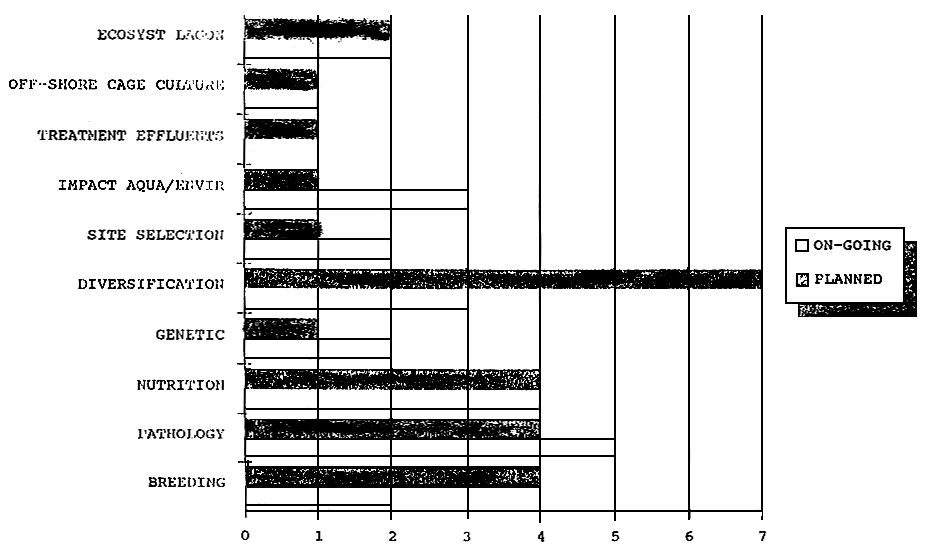
FIGURE 9- PRINCIPAL RESEARCH PROGRAMS WITHIN THE MEDRAP II COUNTRIES

of developing new research programmes.
Budget.
Budgets are generally not indicated except in
the case of Albania, Bulgaria and Cyprus.
Conclusions.
Although difficulties have been encountered to
analyse the real capacity of research of the
institutes in term of number of researchers
facilities equipments, and budget, all countries
have a potential of research in Aquaculture
which could be developped in common through
networking. Detailed informations are
nevertheless necessary to examine in detail
and select relevant laboratories and teams of
research to involve in the sub-net work.
Table 8 - CAPACITY OF RESEARCH IN EACH COUNTRY
| ZONE | COUNTRY | NBR INS | NAME | STAFFS | RESEARC | TECHNIC | AREA(m2 | DRY LAB | WET LAB | HATCHER | PONDS | CAGES | BOATS | BUDGET (U |
| ALBANIA | 1 | SRSF | 55 | 12 | 6 | 200 | 5 | NO | 1 | 15 | 1 | 110000 | ||
| ZONE I | BULGARIA | 1 | IRP | 10 | 4 | 2 | 10000 | 5 | ? | 1 | 2000m2 | 3 | ? | |
| TURKEY | 1 | ARI | 25 | 10 | 4 | 2600 | 3 | 2 | 1 | 3 | 225000 | |||
| YUGOSLAVIA | 1 | IOF | ? | 61 | 2300 | yes | yes | 1 | 1 | ? | ||||
| CYPRUS | 1 | DF | 13 | 3 | 3 | 1500 | 1 | 2 | 2 | 50m2 | 300m2 | 9 | 1780075 | |
| ZONE II | LEBANON | 1 | NCSR | 18 | 14 | 2 | ? | ? | ? | ? | ? | ? | ? | ? |
| SYRIA | NO DATA | |||||||||||||
| EGYPT | 1 | NAC | 200 | 13 | 40 | 40000 | yes | yes | 1 | |||||
| ZONE III | LYBIA | 1 | MBRC | 29 | 9 | 20 | 10000 | 2 | 6 | tanks | ||||
| MALTA | 1 | NAC | 25 | 11 | 14 | 6000 | 3 | 2 | 2 | yes | 2 | ? | ||
| MOROCCO | 1 | ISPM | 31 | 2500 | 2 | |||||||||
| ALGERIA | 1 | ISMAL | 145 | 44 | 39 | yes | yes | |||||||
| ZONE IV | TUNISIA | 2 | INSTOP/CNA | 31 | 9 | yes | yes | 2 | 7,7ha | |||||
| PORTUGAL | INIP/UTAD | NO DATA | ||||||||||||
| Univers |
Informations on capacity of research of each country have been summarized in table No. 8
Data.concern:
Number of instituts involved in different fields of Aquaculture Research.
Total number of staffs and researchers when available.
Main facilities and equipments.
Budget.
The first observation to notice is the lack of complete informations and the difficulty encountered to realise a accurate evaluation, as some countries gave few details on their research institutes.
Nevertheless following preliminary analysis has been done:
Institute involved in Aquaculture Research:
Each country has one or two institutes of research, directly dealing with Aquaculture, most of the time affiliated to Ministry of Agriculture and Fisheries, or Ministry of Technology and Silences.
Connections with Universities are only indicated by few countries.
Number of staffs involved in Research.
Although data have to be completed, the number of researchers involved in aquaculture Research is important in Yugoslavia (61), Algeria, (44), Tunisia (31) and Morocco (31).
In other countries, the number is not excluding 10 to 20 which is relatively low, compared to the Programmes of Research planned to develop in the future.
Facilities and Equipments
Facilities and Equipments don't seem to be a limiting factor as all instituts have numerous laboratories, hatcheries and ponds and equipments to conduct relevant research programmes.
Nevertheless, data indicated in the questionnaires are incomplete and no enough precise to be able to evaluate the possibilities
PRESENTATION OF EVALUATION OF RESEARCH CAPACITY IN THE MEMBER COUNTRIES
1) National report
Each National Coordinator will summarize, in 15 minutes, the situation of research conducted in the field of aquaculture, laking into consideration the specificity of his country and its position in the Sub-region.
Referring to the results of the survey on “national capacity and needs”, each presentation will include :
- analysis of the potential research and identification of research teams involved in aquaculture;
- synthesis of major research activities in relation with different species of major interest for aquaculture development;
- summary of the major constraints of aquaculture research.
Transparencies and slides, with special reference to the National Research Infrastructures, are highly recommended in order to facilitate and simplify the presentations.
See list of Regional Coordinator attached.
NB : The Sub-regional Coordinator will present the results of research capacity and needs when National Coordinators will not participate in the seminar.
2) Synthesis by Sub-regional Coordinators.
Each Sub-regional Coordinator will summarize, in 10 minutes, the principal results of the survey on aquaculture capacities and needs in the Sub-region focusing on :
situation of aquaculture and prospect;
priorities in team of research and development in the field of aquaculture;
research capacity and needs.
These information will help in the redaction of the global synthesis on research capacity in the region made by MEDRAP II Coordination Office and consultant.
22/10/91
| SUB-REGION YUGOSLAVIA | ||
| 10h30 – 10h45 | : | YUGOSLAVIA. |
| 10h45 – 11h00 | : | BULGARIA. |
| 11h00 – 11h15 | : | ALBANIA. |
| 11h15 – 11h30 | : | TURKEY. |
| 11h30 – 11h45 | : | Synthesis by Sub-regional Coordinator. |
| SUB-REGION LIBYA | ||
| 12H00 – 15H15 | : | MALTA. |
| 12h15 – 12h30 | : | EGYPT. |
| 15h30 – 12h45 | : | LIBYA. |
| 12h45 – 13h00 | : | Synthesis by Sub-regional Coordinator. |
| 13h00 – 15h00 | : | Lunch. |
| SUB-REGION SYRIA | ||
| 15h00 – 15h15 | : | CYPRUS. |
| 15h15 – 15h30 | : | LEBANON. |
| 15h30 – 15h45 | : | SYRIA. |
| 15h45 – 16h00 | : | Synthesis by Sub-regional Coordinator. |
| 16h00 – 16h30 | : | Coffee break. |
| SUB-REGION ALGERIA | ||
| 16h30 – 16h45 | : | MOROCCO. |
| 16h45 – 17h00 | : | ALGERIA. |
| 17h00 – 17h15 | : | TUNISIA. |
| 17h15 – 17h30 | : | PORTUGAL. |
| 17h30 – 17h45 | : | Synthesis by Sub-regional Coordinator. |